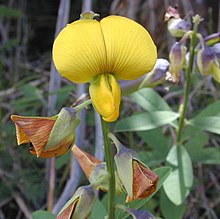| Faboideae Temporal range:
| |
|---|---|

| |
| Crotalaria retusa | |
| Scientific classification | |
| Kingdom: | Plantae |
| Clade: | Tracheophytes |
| Clade: | Angiosperms |
| Clade: | Eudicots |
| Clade: | Rosids |
| Order: | Fabales |
| Family: | Fabaceae |
| Subfamily: | Faboideae |
| Tribes[2][3] | |
| |

| |
| Distribution of the Faboideae | |
| Synonyms | |
| |
The Faboideae are a subfamily of the flowering plant family Fabaceae or Leguminosae. An acceptable alternative name for the subfamily is Papilionoideae, or Papilionaceae when this group of plants is treated as a family.[4]
This subfamily is widely distributed, and members are adapted to a wide variety of environments. Faboideae may be trees, shrubs, or herbaceous plants. Members include the pea, the sweet pea, the laburnum, and other legumes. The pea-shaped flowers are characteristic of the Faboideae subfamily and root nodulation is very common.
- ^ "Fabales". www.mobot.org. Retrieved 2023-06-16.
- ^ "Subfamily Faboideae". Germplasm Resources Information Network (GRIN). Agricultural Research Service (ARS), United States Department of Agriculture (USDA). Retrieved 31 October 2021.
- ^ "Systema Naturae 2000". Retrieved 2010-08-07 – via Taxonomicon.
- ^ McNeill, J.; et al., eds. (2006), International code of botanical nomenclature (Vienna Code) adopted by the seventeenth International Botanical Congress, Vienna, Austria, July 2005 (electronic ed.), Vienna: International Association for Plant Taxonomy, archived from the original on 6 October 2012, retrieved 2011-02-20, Article 19.7